Effects of Phosphate and Silicate Combined Application on Cadmium Form Changes in Heavy Metal Contaminated Soil
Abstract
1. Introduction
2. Materials and Methods
2.1. Experimental Materials
2.2. Experimental Design
2.3. Measurement Indicators and Methods
2.4. Data Processing and Analysis
3. Results and Analysis
3.1. Effect of Phosphate and Thermo-Activated Nano Silicate Combined Application on the Exchangeable Cd Content in Soil
3.2. Effect of Phosphate and Thermo-Activated Nano Silicate Combined Application on the Carbonate-Bound Cd Content in Soil
3.3. Effect of Phosphate and Thermo-Activated Nano Silicate Combined Application on Organic-Bound Cd Content in Soil
3.4. Effect of Phosphate and Thermo-Activated Nano Silicate Combined Application on Iron-Manganese Oxide-Bound Cd Content in Soil
3.5. Effect of Phosphate and Thermo-Activated Nano Silicate Combined Application on Residual Cd Content in Soil
3.6. Effects of Phosphate and Thermo-Activated Nano Silicate Combined Applicationon the Proportions of Cd Forms in Soil
3.7. Comparative Analysis between This Study and Other Studies
4. Discussion of the Mechanism Underlying the Ability of Phosphate and Thermo-Activated Nano Silicate Combined Application to Repair Cd Pollution
5. Conclusions
- The effect of phosphate and thermo-activated nano silicate combined application on the form of heavy metal Cd in soil is mainly as follows: the content of exchangeable Cd was reduced and converted into carbonate bound form, Fe-Mn oxide bound form, organic bound form and the residual form Cd content, indicated that the combined application of phosphate and thermo-activated nano silicate can stabilize heavy metals and reduce the bioavailability of heavy metal Cd.
- When phosphate and thermo-activated nano silicate were applied together, the heavy metal Cd content in soil changed from a biologically available state to a biologically unusable state with increasing culture time and application dose level. For the same incubation time, the order of the effect of potassium dihydrogen phosphate and thermo-activated nano serpentine on remediation of Cd-contaminated soil was: nPS700-2.0 > nPS700-1.0 > nPS700-0.5. The order of the effect of the combined application of potassium dihydrogen phosphate and thermo-activated nano zeolite on the remediation of Cd-contaminated soil was: nPF700-2.0 > nPF700-1.0 > nPF700-0.5. At the same dose level, compared with the combined application of potassium dihydrogen phosphate and thermo-activated nano zeolite, the combined application of potassium dihydrogen phosphate and thermo-activated nano serpentine was more effective in the remediation of Cd-contaminated soil (nPS700-2.0 > nPF700-2.0, nPS700-1.0 > nPF700-1.0, nPS700-0.5 > nPF700-0.5), and the nPS700-2.0 treatment was more effective than the nPF700-2.0 treatment in the remediation of Cd-contaminated soil.
- The effects of potassium dihydrogen phosphate, zeolite, and serpentine after entering the soil are mainly reflected in the following aspects: first, potassium dihydrogen phosphate mainly exists in the form of H2PO4− after entering the soil solution. OH− can be exchanged and resolved from the soil colloid, and the hydroxyl groups in Si-OH on the zeolite surface can be exchanged with PO43−, which makes OH− enter the soil solution. After nano treatment of serpentine, the combination of oxygen in the Si-O-Si bond with Cd2+ can stabilize heavy metal Cd, while OH− in the serpentine magnesia octahedron is easier to dissociate than Mg2+. Second, KH2PO4 in the soil exists in the form of ions, and the particle size of the ions is smaller than the pore size of the silicate minerals, so some ions will enter the pores of the silicate minerals and be adsorbed by the silicate minerals. Third, after silicate minerals are applied to the soil, due to the high pH of the minerals themselves, the pH of the soil environment will increase and H2PO4− will be converted into PO43−. PO43− is the bridge between the soil surface and Cd2+. As the soil surface adsorbs PO43−, the negative charge on the surface increases, which is conducive to the non-specific adsorption of Cd2+. Additionally, the increased net surface charge promotes the continuous adsorption of Cd2+ by the soil via electrostatic adsorption. To sum up, the combined application of potassium dihydrogen phosphate and thermo-activated nano serpentine and the combined application of potassium hydrogen phosphate and thermo-activated nano zeolite can repair cadmium pollution.
Author Contributions
Funding
Institutional Review Board Statement
Informed Consent Statement
Data Availability Statement
Acknowledgments
Conflicts of Interest
References
- Gallego, S.M.; Benavídes, M.P.; Tomaro, M.L. Effect of heavy metal ion excess on sunflower leaves: Evidence for involvement of oxidative stress. Plant. Sci. 1996, 121, 151–159. [Google Scholar] [CrossRef]
- Huang, Y.Z.; Zhu, Y.G. A review on cadmium contamination in forest ecosystem. Acta Ecol. Sin. 2004, 24, 101–108. [Google Scholar] [CrossRef]
- Lu, R.K.; Xiong, L.M.; Shi, Z.Y. Study on cadmium in soil-crop system. Soils 1992, 24, 129–132. Available online: https://www.cnki.com.cn/Article/CJFDTOTAL-TURA199203004.htm (accessed on 17 February 2023).
- Zhang, X.M.; Yang, Q.W.; Li, Y. Progress of status and remediation of soil cadmium pollution. J. Hebei Agric. Sci. (China) 2010, 14, 79–81. [Google Scholar] [CrossRef]
- Karblane, H. The effect of organic lime and phosphorus fertilizers on Pb, Cd and Hg content in plants. Pro. Est. Acad. Sci. Ecol. 1994, 52–56. Available online: https://eurekamag.com/research/003/302/003302290.php (accessed on 17 February 2023).
- Wang, K.J.; Xing, B.S. Adsorption and Desorption of Cadminum by Goethite Pretreated with Phosphate. Chemosphere 2002, 48, 665–670. [Google Scholar] [CrossRef]
- Chen, S.B.; Zhu, Y.G.; Yang, J.C. Mechanism of the effect of phosphorus on bioavailability of heavy metals in soil-plant systems. Chin. J. Environ. Eng. 2003, 4, 1–7. [Google Scholar] [CrossRef]
- Huang, Y.Z. Interaction between Cadmium and phosphorus, zinc, iron and calcium and its ecological effects. J. Ecol. 2004, 23, 92–97. [Google Scholar] [CrossRef]
- Gupta, K.; Maity, A.; Ghosh, U.C. Manganese associated nanoparticles agglomerate of iron(Ⅲ) oxide: Synthesis, characterization and arsenic(Ⅲ) sorption behavior with mechanism. J. Hazard. Mater. 2010, 184, 832–842. [Google Scholar] [CrossRef]
- Song, Z.G.; Lian, F.; Yu, Z.H.; Zhu, L.Y.; Xing, B.S.; Qiu, W.W. Synthesis and characterization of a novel MnOx-loaded biochar and its adsorption properties for Cu2+ in aqueous solution. Chem. Eng. J. 2014, 242, 36–42. [Google Scholar] [CrossRef]
- Yaqqob, A.A.; Parveen, T.; Umar, K.; Ibrahim, M.N.M. Role of nanomaterials in the treatment of wastewater: A review. Water 2020, 12, 495. [Google Scholar] [CrossRef]
- Idris, M.O.; Ibrahim, M.N.M.; Ahmad, A.; Alshammari, M.B. Introduction of Adsorption Techniques for Heavy Metals Remediation. In Emerging Techniques for Treatment of Toxic Metals from Wastewater; Elsevier: Amsterdam, The Netherlands, 2023; pp. 1–18. [Google Scholar] [CrossRef]
- Zwonitzer, J.C.; Pierzynski, G.M.; Hettiarachchi, G.M. Effects of phosphorus additions on lead, cadmium, and zinc bioavailabilities in a metal-contaminated soil. Water. Air. Soil. Poll. 2003, 143, 193–209. [Google Scholar] [CrossRef]
- Raicevic, S.; Kaludjerovic-Radoicic, T.; Zouboulis, A.I. In situ stabilization of toxic metals in polluted soils using phosphates: Theoretical prediction and experimental verification. J. Hazard. Mater. 2005, B117, 41–53. [Google Scholar] [CrossRef]
- Matusik, J.; Bajda, T.; Manecki, M. Immobilization of aqueous cadmium by addition of phosphates. J. Hazard. Mater. 2008, 152, 1332–1339. [Google Scholar] [CrossRef]
- Mignardi, S.; Corami, A.; Ferrini, V. Evaluation of the effectiveness of phosphate treatment for the remediation of mine waste soils contaminated with Cd, Cu, Pb and Zn. J. Chemosphere 2012, 86, 354–360. [Google Scholar] [CrossRef]
- Xiao, R.B.; Huang, Z.H.; Li, X.N.; Chen, W.P.; Deng, Y.R.; Han, C.L. Lime and Phosphate Amendment Can Significantly Reduce Uptake of Cd and Pb by Field-Grown Rice. Sustainability 2017, 9, 430. [Google Scholar] [CrossRef]
- Chen, D.; Wang, X.B.; Wang, X.L.; Feng, K.; Zhang, X.M.; Song, J.; Bei, J.L. Screening of Passivators for Cadmium-contaminated Red Soil and Their Effects on Soil Remediation. J. Ecol. Rural Environ. 2020, 36, 115–120. [Google Scholar] [CrossRef]
- NiñoSavala, A.G.; Weishaar, B.; Franzaring, J.; Liu, X.J.; Fangmeier, A. Cd and Zn concentrations in soil and silage maize following the addition of P fertilizer. Agronomy 2021, 11, 2336. [Google Scholar] [CrossRef]
- Su, J.C.; Wang, X.B.; Wang, X.L.; Dong, J.N.; Wang, H.C.; Saima, P.M.; Feng, C. Passivation effects of different passivators on cadmium contaminated yellow soil and brown soil. Jiangsu Agric. Sci. (China) 2021, 49, 192–198. [Google Scholar] [CrossRef]
- Castaldi, P.; Melis, P.; Silvetti, M.; Deiana, P.; Garau, G. Influence of pea and wheat growth on Pb, Cd, and Zn mobility and soil biological status in a polluted amended soil. Geoderma 2009, 151, 241–248. [Google Scholar] [CrossRef]
- Hamidpour, M.; Afyuni, M.; Kalbasi, M.; Khoshgoftarmanes, A.H.; Inglezakis, V.J. Mobility and plant-availability of Cd(II) and Pb(II) adsorbed on zeolite and bentonite. Appl. Clay. Sci. 2010, 48, 342–348. [Google Scholar] [CrossRef]
- Taparcevska, J.; Markovska, L.; Koumanova, B.; Meshko, V. Diffusion models for adsorption kinetics of Zn(2+), Cd(2+) and Pb(2+) onto natural zeolite. Water Sci. Technol. 2010, 62, 1136–1142. [Google Scholar] [CrossRef]
- Fard, N.E.; Givi, J.; Houshmand, S. The effect of zeolite, bentonite and sepiolite minerals on heavy metal uptake by sunflower. J. Sci. Tech. Greenh. Cult. 2015, 6, 55–64. [Google Scholar] [CrossRef]
- Javadian, H.; Ghorbani, F.; Tayebi, H.A.; Asl, S.M.H. Study of the adsorption of Cd (II) from aqueous solution using zeolite-based geopolymer; synthesized from coal fly ash, kinetic, isotherm and thermodynamic studies. Arab. J. Chem. 2015, 8, 837–849. [Google Scholar] [CrossRef]
- Andrejkovičová, S.; Sudagar, A.; Rocha, J.; Patinha, C.; Hajjaji, W.; Silva, E.F.; Velosa, A.; Rocha, F. The effect of natural zeolite on microstructure; mechanical and heavy metals adsorption properties of metakaolin based geopolymers. Appl. Clay Sci. 2016, 126, 141–152. [Google Scholar] [CrossRef]
- Ma, J.; Sun, X.Y.; Suo, L.N.; Wang, L.; Sun, N.; Xu, N.; Li, J. Effects of two modifiers on passivation of cadmium in calcareous soil in northern China and growth of pakchoi. Acta Agric. Boreali-Sin. 2022, 37, 152–159. [Google Scholar] [CrossRef]
- Ren, C.; Zhu, L.W.; Li, J.T.; Du, Q.Q.; Xiao, J.H.; Wang, H.; Zhao, R. Study on the passivation effect of different treatments on weakly acidic cadmium polluted soil. J. Ecol. Rural Environ. (China) 2022, 38, 383–390. [Google Scholar] [CrossRef]
- Li, X.J.; Wang, L.J.; Lu, A.H.; Wang, C.Q. Preliminary study on the mechanism of natural serpentine. Rock. Miner. J. (China) 2003, 386–390. [Google Scholar] [CrossRef]
- Morante-Carballo, F.; Montalvan-Burbano, N.; Carrion-Mero, P.; Jacome-Francis, K. Worldwide Research Analysis on Natural Zeolites as Environmental Remediation Materials. Sustainability 2021, 13, 6378. [Google Scholar] [CrossRef]
- Yang, Z.K. Treatment of copper-containing wastewater with serpentine. Environ. Sci. Technol. (China) 1997, 17–19. [Google Scholar] [CrossRef]
- Guo, J.X.; Yuan, C.G. Experimental study on the treatment of heavy metals in sewage by serpentine adsorption. Fine. Chem. (China) 2000, 17, 586–589. [Google Scholar] [CrossRef]
- Luo, W.H. Study on the Serpentine Mineral and Its Adsorption Performance; Chang’an University: Xi’an, China, 2008; Available online: https://cdmd.cnki.com.cn/Article/CDMD-11941-2009066599.htm (accessed on 17 February 2023).
- Zhang, Z.M.; Huang, Z.B.; Shan, R.J.; Feng, Y.Y.; Yang, J.C.; Liu, Y.C. Adsorption and desorption of Pb, Cd and As in contaminated soil by environmental materials. Environ. Eng. (China) 2013, 31, 122–126. Available online: https://www.cnki.com.cn/Article/CJFDTOTAL-HJGC201303033.htm (accessed on 17 February 2023).
- Wang, X.; Liang, C.H.; Du, L.Y.; Wu, Y.; Yin, Y.; Hu, Y. Effects of Natural and Thermal Activation Serpentine on Cadmium Formations in Contaminated Soil. J. Soil. Water. Conserv. (China) 2015, 29, 231–256. [Google Scholar] [CrossRef]
- Wang, X.L.; Liang, C.H.; Ma, Z.H.; Han, Y. Effect of application phosphate and zeolite on morphological conversion of soil Cd. Environ. Sci. (China) 2015, 36, 1437–1444. [Google Scholar] [CrossRef]
- Bao, S.D. Agrochemical Analysis of Soil, 3rd ed.; China Agriculture Press: Beijing, China, 2000; pp. 25–200. Available online: https://xueshu.baidu.com/usercenter/paper/show?paperid=6cb4c2ed2a15c8650f16c6c609fa7307&site=xueshu_se (accessed on 17 February 2023).
- Xie, F.; Liang, C.H.; Meng, Q.H.; Gao, Y.D.; Song, S.Y. Effects of natural zeolite and lime on form transformation of cadmium in soil. Chin. J. Environ. Eng. 2014, 8, 3506–3510. Available online: https://www.researchgate.net/publication/287325369_Effects_of_natural_zeolite_and_lime_on_form_transformation_of_cadmium_in_soil (accessed on 17 February 2023).
- Qi, N.; Liang, C.H.; Wang, X.; Yin, Y. The characteristics of thermal-modified serpentine’s adsorption of cadmium. Resour. Ind. (China) 2015, 17, 56–60. [Google Scholar] [CrossRef]
- Cao, C.Y.; Liang, C.H.; Yin, Y.; Du, L.Y. Thermal activation of serpentine for adsorption of cadmium. J. Hazard. Mater. 2017, 329, 222–229. [Google Scholar] [CrossRef]
- Tessier, A.; Campbell, P.G.C.; Bisson, M. Sequential extraction procedure for the speciation of particulate trace metals. Anal. Chem. 1979, 51, 844–851. [Google Scholar] [CrossRef]
- Liu, E.L.; Wang, L. Distribution of different heavy metal forms in soil and their bio-availability. J. Anhui Agric. Sci. (China) 2006, 34, 547–549. [Google Scholar] [CrossRef]
- Yang, H.F.; Yan, M.; Wang, Y.B.; Liu, D.Y. Activities of soil enzymes related to forms and distribution of heavy metals in paddy soil in Anhui province. Soils (China) 2007, 39, 753–759. [Google Scholar] [CrossRef]
- Liu, Y.X.; Yang, Q.X.; Chang, X.B. Analysis on the forms of heavy metals in the sludge of Yantai wastewater treatment plant. J. Anhui Agric. Sci. (China) 2008, 36, 11977–11979. [Google Scholar] [CrossRef]
- Ren, L.X. Soil heavy metal morphology and solubility organic matter environmental behavior. Environ. Sci. Technol. (China) 2008, 31, 69–73. [Google Scholar] [CrossRef]
- Li, X.J.; Qiu, S.; Zhao, J.; Zhang, C.P.; Zeng, D.J.; Liu, S.H. Studies on manganese absorption and soil remediation of four ornamental plants. Guangxi Agric. Sci. (China) 2010, 41, 951–954. [Google Scholar] [CrossRef]
- Li, M.Y.; Zhang, Y.; Du, L.Y.; Su, X.N.; Dong, S.P.; Lan, X.P. Influence of Biochar and Zeolite on the fraction transform of Cadmium in contaminated soil. J. Soil Water. Conserv. 2014, 28, 249–252. [Google Scholar] [CrossRef]
- Wang, B.L.; Xie, Z.M. Effects of phosphorus application on translocation of lead, zinc and cadmium in the soil-plant system. Environ. Sci. 2008, 29, 3225–3229. [Google Scholar] [CrossRef]
- Zou, X.Z. Study on the Adsorption Characteristics of Copper Ions in Variable Charge Soil and Constant Charge Soil; Institute of Soil Science, Chinese Academy of Sciences: Nanjing, China, 1999; pp. 58–59. Available online: https://d.wanfangdata.com.cn/thesis/Y370317 (accessed on 17 February 2023).
- Zhou, T.F.; Tao, C.J.; Li, X.L.; Chen, Y.N.; Chen, X.R.; Jia, S.J.; Yuan, F.; Chen, F.R. Effects of phosphoric acid on the adsorption characteristics of Cadmium; Mercury and Lead from paddy soil. Resour. Surv. Environ. 2009, 30, 130–138. [Google Scholar] [CrossRef]
- Mahabadi, A.A.; Hajabbasi, M.A.; Khademi, H.; Kazemian, H. Soil cadmium stabilization using an Iranian natural zeolite. Geoderma 2007, 137, 388–393. [Google Scholar] [CrossRef]
- Anderson, M.A.; Robin, A.J. Aqueous Solution Adsorption Chemistry; Liu, L., Translator; Scientific Publishing House: Beijing, China, 1989; pp. 22–30. Available online: http://www.ckcest.zju.edu.cn/Engineering/ShowBook.action?BookNo=07107623 (accessed on 17 February 2023).
- Tartaj, P.; Cerpa, A.; García-González, M.T.; Serna, C.J. Surface instability of serpentine in aqueous suspensions. J. Colloid. Interf. Sci. 2000, 231, 176–181. [Google Scholar] [CrossRef]
- Feng, B.; Lu, Y.P.; Feng, Q.M.; Ding, P.; Luo, N. Mechanisms of surface charge development of serpentine mineral. Trans. Nonferrous. Met. Soc. (China) 2013, 23, 1123–1128. [Google Scholar] [CrossRef]
- Li, M.Y.; Zhang, Y.; Du, L.Y.; Su, X.N.; Dong, S.P.; Lan, X.P. Effect of biocarbon and zeolite mixing on morphological conversion of soil Cd. J. Soil. Water. Conserv. (China) 2014, 28, 248–252. [Google Scholar]
- Jin, Z.; Jia, Y.; Luo, T.; Kong, L.T.; Sun, B.; Shen, W.; Meng, F.L.; Liu, J.H. Efficient removal of fluoride by hierarchical MgO microspheres: Performance and mechanism study. Appl. Surf. Sci. 2015, 357, 1080–1088. [Google Scholar] [CrossRef]
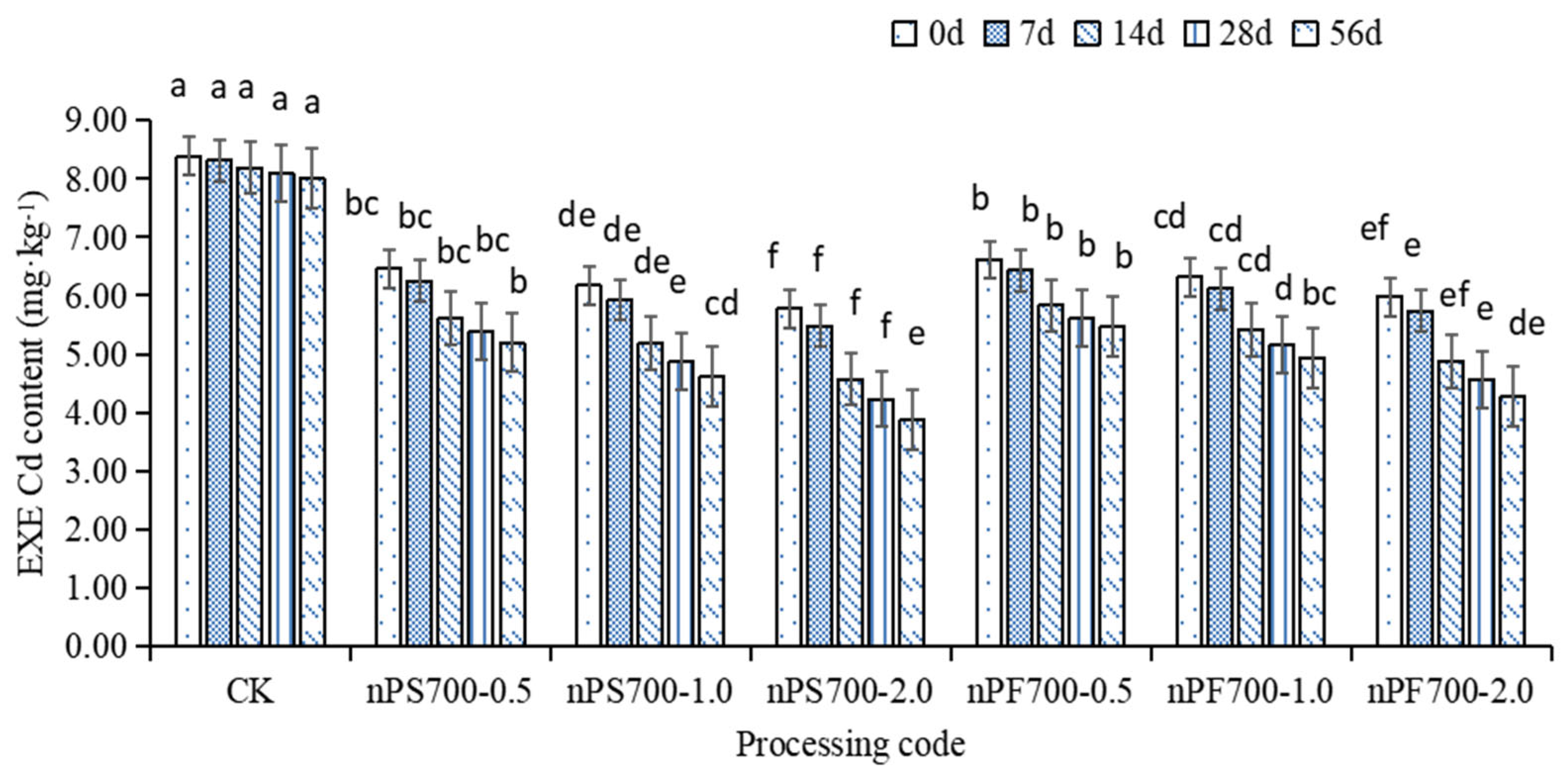
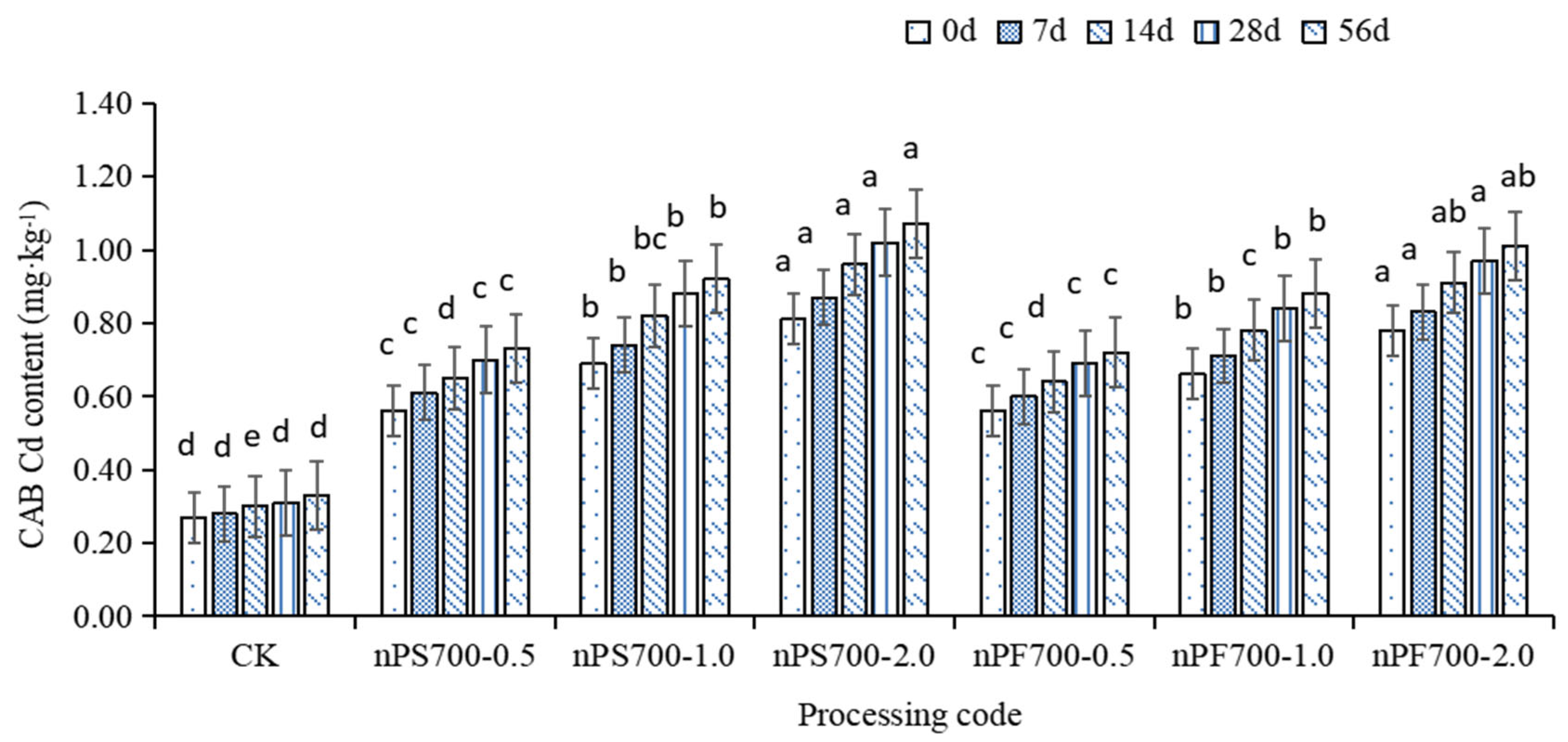
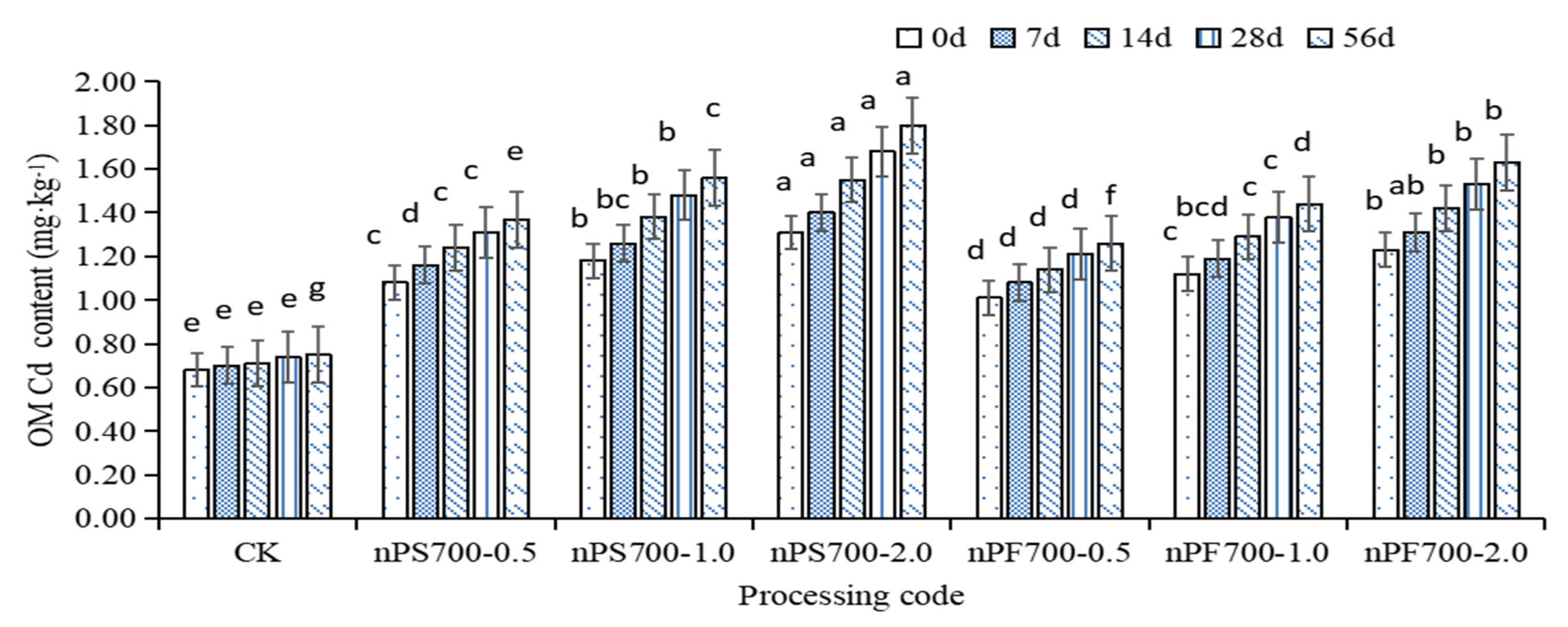
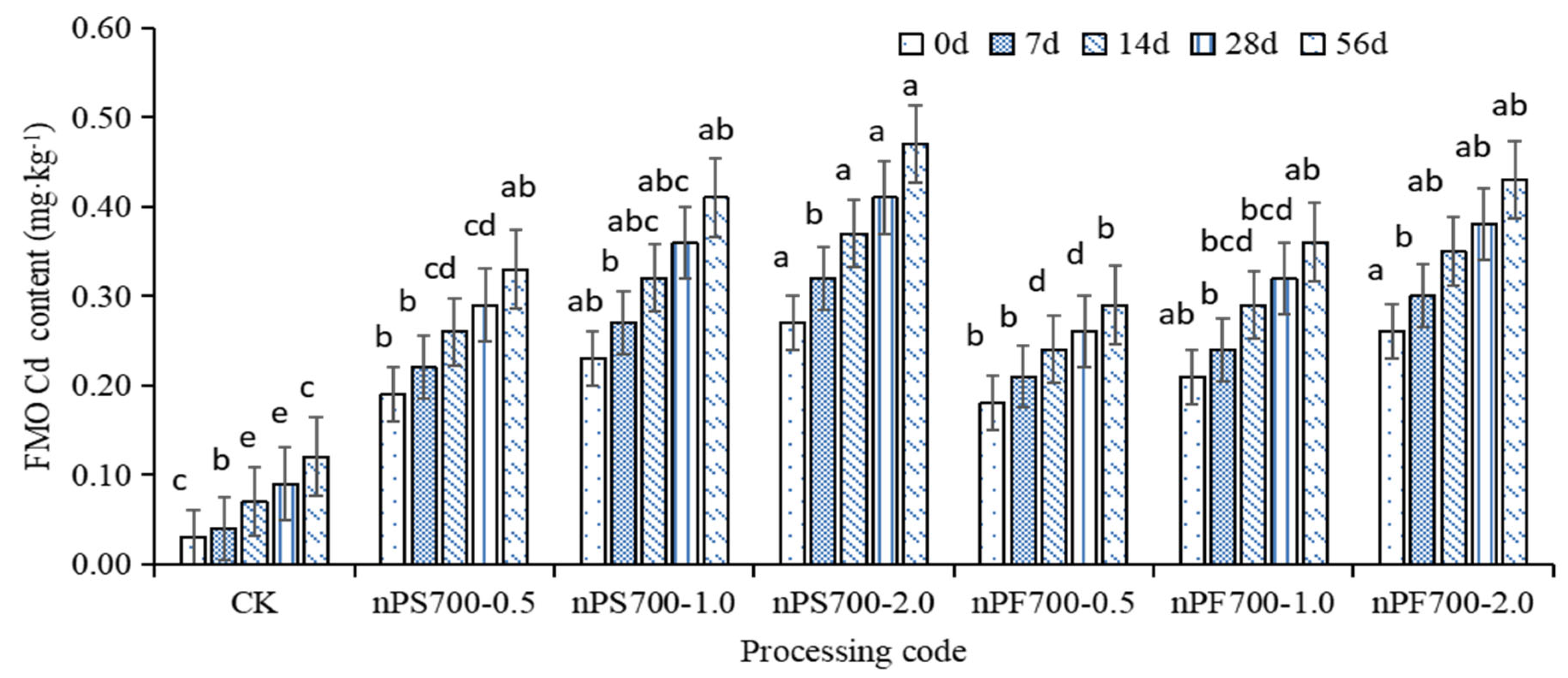
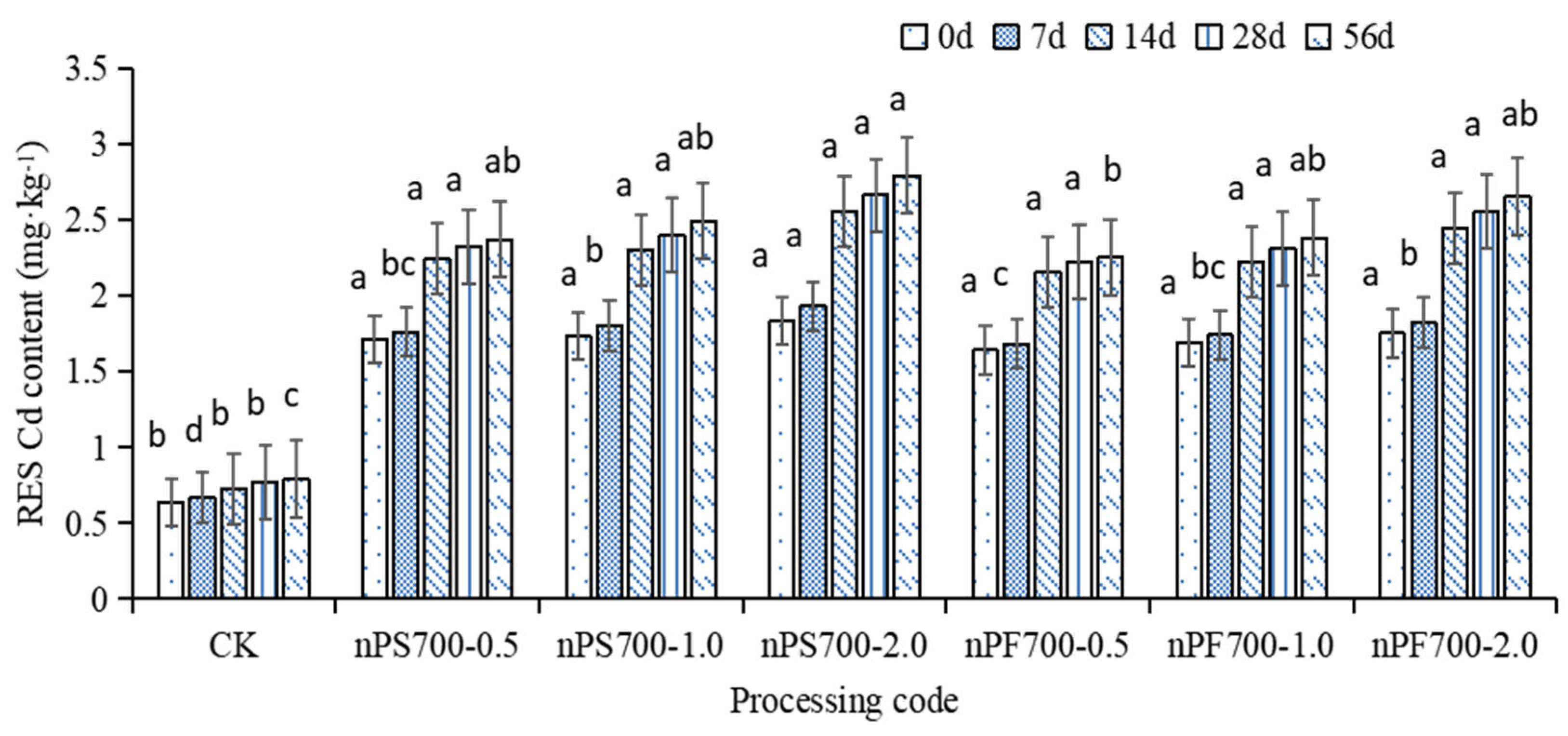

| Composition | SiO2 | Al2O3 | MgO | K2O | CaO | Na2O | Fe2O3 | P2O5 | Other |
|---|---|---|---|---|---|---|---|---|---|
| Content in soil (wt. %) | 72.23 | 10.33 | 9.83 | 2.55 | 2.23 | 1.66 | 0.17 | 0.23 | 0.16 |
| Content in zeolite (wt. %) | 76.32 | 12.49 | 3.78 | 3.24 | 2.30 | 1.29 | 0.58 | 0 | 0 |
| Content in serpentine (wt. %) | 57.24 | 0.11 | 37.97 | 0 | 3.20 | 0.18 | 1.30 | 0 | 0 |
| Sample | Potassium Dihydrogen Phosphate Dosage (%) | 700 °C Nano Serpentine Dosage (%) | 700 °C Nano Zeolite Dosage (%) |
|---|---|---|---|
| CK | 0 | 0 | 0 |
| nPS700-0.5 | 0.17 | 0.33 | |
| nPS700-1.0 | 0.33 | 0.67 | |
| nPS700-2.0 | 0.67 | 1.33 | |
| nPF700-0.5 | 0.17 | 0.33 | |
| nPF700-1.0 | 0.33 | 0.67 | |
| nPF700-2.0 | 0.67 | 1.33 |
| Cd Form Name | Extractants and Extraction Conditions |
|---|---|
| Exchangeable state | 8 mL 1 mol·L−1 MgCl2 solution (pH adjusted to 7.0 with 0.1 mol·L−1 HCl) and continuously shaken horizontally at 25 °C for 1 h |
| Carbonate-bound state | 8 mL 1 mol·L−1 NaOAc solution (pH adjusted to 5.0 with HOAc) and continuously shaken horizontally at 25 °C for 5 h |
| Iron-manganese oxide-bound state | 20 mL 0.04 mol·L−1 NH2OH·HCl HOAc (25%, v/v) solution, stirred continuously in a water bath at 96 ± 3 °C for 6 h |
| Organic-bound state |
|
| Residue state | HCl + HNO3 + HF + HClO4 |
Disclaimer/Publisher’s Note: The statements, opinions and data contained in all publications are solely those of the individual author(s) and contributor(s) and not of MDPI and/or the editor(s). MDPI and/or the editor(s) disclaim responsibility for any injury to people or property resulting from any ideas, methods, instructions or products referred to in the content. |
© 2023 by the authors. Licensee MDPI, Basel, Switzerland. This article is an open access article distributed under the terms and conditions of the Creative Commons Attribution (CC BY) license (https://creativecommons.org/licenses/by/4.0/).
Share and Cite
Wang, X.; Zou, H.; Liu, Q. Effects of Phosphate and Silicate Combined Application on Cadmium Form Changes in Heavy Metal Contaminated Soil. Sustainability 2023, 15, 4503. https://doi.org/10.3390/su15054503
Wang X, Zou H, Liu Q. Effects of Phosphate and Silicate Combined Application on Cadmium Form Changes in Heavy Metal Contaminated Soil. Sustainability. 2023; 15(5):4503. https://doi.org/10.3390/su15054503
Chicago/Turabian StyleWang, Xiuli, Hongtao Zou, and Qi Liu. 2023. "Effects of Phosphate and Silicate Combined Application on Cadmium Form Changes in Heavy Metal Contaminated Soil" Sustainability 15, no. 5: 4503. https://doi.org/10.3390/su15054503
APA StyleWang, X., Zou, H., & Liu, Q. (2023). Effects of Phosphate and Silicate Combined Application on Cadmium Form Changes in Heavy Metal Contaminated Soil. Sustainability, 15(5), 4503. https://doi.org/10.3390/su15054503





